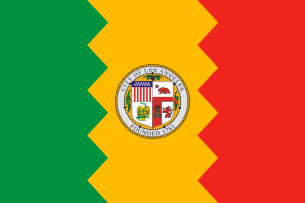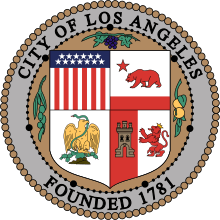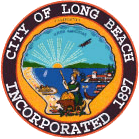Los Angeles Unified School District
The Los Angeles Unified School District (LAUSD) is the largest (in terms of number of students) public school system in the U.S. state of California and the 2nd largest public school district in the United States. Only the New York City Department of Education has a larger student population. During the 2016–2017 school year, LAUSD served around 734,641 students, including 107,142 students at independent charter schools and 69,867 adult students.[2] During the same school year, it had 26,556 teachers and 33,635 other employees.[2] It is the second largest employer in Los Angeles County, after the county government.[3] The total school district operating budget for 2016–2017 was $7.59 billion.[2]
| Los Angeles Unified School District | |
|---|---|
 | |
| Location | |
| Los Angeles, surrounding areas California United States | |
| District information | |
| Type | Public |
| Grades | Pre K-12 |
| Established | 1961 |
| Superintendent | Austin Beutner |
| Schools | 1,302[1] |
| Budget | $7.59 billion |
| Students and staff | |
| Students | 734,641 |
| Teachers | 26,556 |
| Other information | |
| Teachers' unions | United Teachers Los Angeles, California Teachers Association |
| Website | lausd.net |
The school district consists of Los Angeles and all or portions of several adjoining Southern California cities. LAUSD has its own police force, the Los Angeles School Police Department, which was established in 1948 to provide police services for LAUSD schools.[4] The LAUSD enrolls a third of the preschoolers in Los Angeles County, and operates almost as many buses as the Los Angeles County Metropolitan Transportation Authority.[5] The LAUSD school construction program rivals the Big Dig in terms of expenditures, and LAUSD cafeterias serve about 500,000 meals a day, rivaling the output of local McDonald's restaurants.[5]
The LAUSD has been criticized in the past for extremely crowded schools with large class sizes, high drop-out[6] and expulsion rates, low academic performance in many schools, poor maintenance and incompetent administration.[7][8] In 2007, LAUSD's dropout rate was 26 percent for grades 9 through 12.[9] But more recently, there are signs that the district is showing improvement, both in terms of dropout and graduation rates.[10] An ambitious renovation program intended to help ease the overcrowded conditions has been completed.[11] As part of its school-construction project, LAUSD opened two high schools (Santee Education Complex and South East) in 2005 and four high schools (Arleta, Contreras Learning Complex, Panorama, and East Valley) in 2006.[12]
Governance

Los Angeles Unified School District is governed by a seven-member Board of Education, which appoints a superintendent, who runs the daily operations of the district. Members of the board are elected directly by voters from separate districts that encompass communities that the LAUSD serves. The district's current superintendent is Austin Beutner. The district's former superintendents are Michelle King and Ramon C. Cortines. The Board of Education selected King for superintendent in January 2016; she served until announcing in January 2018 her retirement plans. Vivian Ekchian became acting superintendent until the Board election of Beutner in May 2018. Cortines was appointed acting superintendent after the school board decided to buy out the contract of David L. Brewer III, a former Navy Vice-Admiral who served as head of the Navy's Education and Training Division and was in charge of the SeaLift Command. From 2001 until his retirement in October 2006, the district was led by former Governor of Colorado and Democratic Party chairman Roy Romer.
The seven current members of Board of Education include George McKenna (District 1), Board President Monica Garcia (District 2), Scott Schmerelson (District 3), Board Vice President Nick Melvoin (District 4), Kelly Fitzpatrick-Gonez (District 6), Richard Vladovic (District 7), [13]and Jackie Goldberg (District 5) following a special election held after the resignation of Dr. Ref Rodriguez in July 2018.[14]
In the March 2015 Los Angeles City Council and School Board elections, voters approved Charter Amendment 2, which allows the Los Angeles Unified School District Board of Education to change their election dates to even-numbered years. It will take effect with the March 2020 Primary election and the runoff in November 2020.
Every LAUSD household or residential area is zoned to an elementary school, a middle school and a high school, in one of the eight local school districts. Each local school district is run by an area superintendent and is headquartered within the district.
History
| Year | Student Enrollment | Percent change |
|---|---|---|
| 1993–1994 | 639,129 | — |
| 1994–1995 | 632,973 | −1.0% |
| 1995–1996 | 647,612 | +2.3% |
| 1996–1997 | 667,305 | +3.0% |
| 1997–1998 | 680,430 | +2.0% |
| 1998–1999 | 695,885 | +2.3% |
| 1999–2000 | 710,007 | +2.0% |
| 2000–2001 | 721,346 | +1.6% |
| 2001–2002 | 735,058 | +1.9% |
| 2002–2003 | 746,852 | +1.6% |
| 2003–2004 | 747,009 | +0.0% |
| 2004–2005 | 741,367 | −0.8% |
| 2005–2006 | 727,319 | −1.9% |
| 2006–2007 | 707,626 | −2.7% |
| 2007–2008 | 693,680 | −2.0% |
| 2008–2009 | 687,534 | −0.9% |
| 2009–2010 | 670,745 | −2.4% |
| 2010–2011 | 667,251 | −0.5% |
| 2011-2012 | 662,140 | −0.8% |
| 2012-2013 | 655,494 | −1.0% |
| 2013-2014 | 653,826 | −0.3% |
| 2014-2015 | 646,683 | −1.1% |
| 2015-2016 | 639,337 | −1.1% |
| 2016-2017 | 633,621 | −0.9% |
| 2017-2018 | 621,414 | −1.9% |
| Source: [15] | ||
The Los Angeles Unified School District was once composed of two separate districts: the Los Angeles City School District, formed on September 19, 1853, and the Los Angeles City High School District, formed in 1890. The latter provided 9–12 educational services, while the former did so for K-8. On July 1, 1961 the Los Angeles City School District and the Los Angeles City High School District merged, forming the Los Angeles Unified School District.[16]
On January 31, 1957, a DC7B crashed into the schoolyard of Pacoima Junior High School in Pacoima in the San Fernando Valley of Los Angeles, California following a midair collision with a US military plane, resulting in the deaths of the four crew members aboard the DC-7B, the pilot of the Scorpion jet, and two students on the ground, a third died three days later. Additionally, approximately seventy-eight students suffered injuries which ranged from minor to life-threatening.
The annexation left the Topanga School District and the Las Virgenes Union School District (then renamed to the West County Union High School District) as separate remnants of the high school district. The high school district changed its name to the West County Union High School District. LAUSD annexed the Topanga district on July 1, 1962. Since the Las Virgenes Union School District had the same boundary as the remaining West County Union High School District, on July 1, 1962 West County ceased to exist.[16]
Desegregation
In 1961, Jackson vs. Pasadena School District was a local predecessor of Crawford v. Board of Ed. Of Los Angeles. Jar R. Jackson and Lucia Jackson, noticed that the local Washington Junior High School zone in the district was separated between white and black students. They filed a lawsuit against the district spearheaded by attorney Samuel Sheats, the president of the National Association for the Advancement of Colored People (NAACP) in Pasadena. In 1963 the Supreme Court of California the Jackson's won through an appeal after the Pasadena Superior Court dismissed their complaint. The court ruled typically for the times, that school boards needed to refrain from intentional actions towards segregating students despite the reasons for it.[17] However, what was different about this ruling is that it demanded an active integration of school that had a substantial racial difference.[18] A setback to this ruling, as well as other rulings in Los Angeles City School District and surrounding areas, was the language used to ask for integration.[19] The language implied that integration was required if it was “reasonably feasible.” This caveat was used by local school districts to claim integration was not feasible due to financial or other limitations
In 1963, a lawsuit, Crawford v. Board of Ed. of Los Angeles[20] was filed to end segregation in the district. The California Supreme Court required the district to come up with a plan in 1977. The board returned to court with what the court of appeal years later would describe as "one of if not the most drastic plan of mandatory student reassignment in the nation."[21] A desegregation busing plan was developed to be implemented in the 1978 school year. Two lawsuits to stop the enforced busing plan, both titled Bustop, Inc. v. Los Angeles Bd. of Ed., were filed by the group Bustop Inc. and were petitioned to the United States Supreme Court.[22][23] The petitions to stop the busing plan were subsequently denied by Justice Rehnquist and Justice Powell. California Constitutional Proposition 1, which mandated that busing follow the Equal protection clause of the U.S. Constitution passed in 1979 with 70% of the vote. The Crawford v. Board of Ed. of Los Angeles lawsuit was heard in the Supreme Court in 1982.[24] The Supreme Court upheld the decision that Proposition 1 was constitutional.
After the Crawford v. Board of Ed. Of Los Angeles was processed in Los Angeles, and just as the outcome was upheld by the Supreme Court, Judge Paul Egly, created the Los Angeles Monitoring Committee(May 1978).[25][26] Helen V. Smookler was the Executive Director of the committee and she managed 12 members from the community, ranging from all diverse backgrounds representative of the Los Angeles demographics. Each member spearheaded a sub-committee that was charged with overseeing and working on sustaining the desegregation of “all senior high schools, majority of junior highs, and most elementary schools.“[27] The committee’s Integration project master plan (1979-1980) expanded beyond the Brown ruling because Los Angeles was a hub of multiculturalism. Hence, the “(1) logical and sensible, and (2) economical and inexpensive in time and effort and dollars” approach is to desegregate minority school pupils and integrate them into other schools.[28] A goal of the integration process was to have small class sizes so that the diverse student population would have more individualized support when dealing with possible racial differences. By the mid-1980s the desegregation process was in compliance with the Supreme Court ruling and California propositions.[29][30][31] However, some would say that Los Angeles is struggling with segregation again due to socioeconomic impact on minority communities, the housing crisis, and an increasingly tense political climate.
Labor relations
Historically, unions have long played an important role in the operation and governance of L.A. Schools. These include the United Teachers of Los Angeles, (UTLA) which currently represents over 35,000 teachers and the Associated Administrators of Los Angeles (AALA).[32][33]
On April 13, 1970, UTLA members walked out for the first time on what was predicted to be a five-week strike.[34] Teachers demanded raises in top level salaries from $13,650 to approximately 20,000, reductions in class size and increased spending on reading and other programs. After 23 days, the strike ended on May 13, 1970. Teachers obtained a 5% pay raise, creation of advisory panels and new reading programs.
On May 30, 1989, approximately 20,000 UTLA members went out on strike for higher pay and more administrative control.[35] [36] [37] The strike lasted nine days starting on May 30, 1989. The months preceding the strike were highly contentious. Numerous negotiation tactics were deployed by both sides including teacher demonstrations, threats to withhold grades, threats to dock teacher pay and many hard fought court battles. Union demands included pay increases and better school conditions. Thousands of substitute teachers were mobilized in preparation for the strike, and teachers prepared by saving money to endure a long walk-out. Many of the city's 600 schools reportedly remained open but with lower attendance. The district reported that 8,642 teachers crossed picket lines, and public rhetoric by both sides was critical and intense. [38] After negotiations, a settlement was reached and a three-year contract produced. Both sides claimed victory. Despite successful teacher pay raises obtained in the settlement, a massive economic recession in 1990 caused negotiations in 1991 to focus on preventing massive layoffs due to hundreds of millions in budget deficits.[39] Salaries were cut to avoid layoffs, ameliorating the positive results of the 1989 strike.
In 2009, UTLA members authorized a one-day strike. [40]
In September of 2018, 98% of UTLA members authorized a strike over numerous disputes and a failure of months of contract negotiations. These included familiar issues such as salary increases, more librarians and nurses, and classroom size reduction. However, a new issue also predominated the discussions -- i.e., authority and control over the proliferation of charter schools.[41] Fact-finding efforts took several months, but resulted in a ruling stating that the union had not bargained in good faith on several of the non-pay related matters.[42][43]. The fact-finding report failed to resolve matters and UTLA stated that a strike would proceed on January 10, 2019.[44] On January 14, 2019, 30,000 teachers walked out in what was the first teacher's strike in Los Angeles since 1989.[45]
Dress codes and school uniforms
Since 1995, uniforms or standardized dress codes are used in most elementary and middle schools as well as a few high schools.
Reform
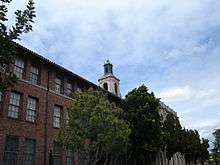
Various attempts at program reform have been attempted. In one reform, individual schools were given more authority over day-to-day decisions and public school choice, authored by school board member Yolie Flores was implemented. In the 1990s, the Los Angeles Education Alliance for Restructuring Now (LEARN) and the Los Angeles Annenberg Metropolitan Project (LAAMP) were created, giving principals even more authority to make changes in curriculum hopefully benefiting students. Regardless, student achievement failed to increase.[46]
Later attempted reform led to the creation of eleven minidistricts with decentralized management and their own individual superintendents.[47] Due to the cost of this additional bureaucracy, then Superintendent Romer called for reversing the measure and re-merging the minidistricts. United Teachers Los Angeles, the union representing LAUSD teachers, supported this plan. Eight numbered Local Districts arose from the merger replacing the eleven districts.
Consultants
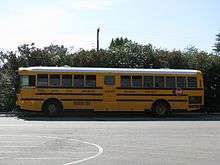
Although grappling with economic shortfalls, the Los Angeles Unified School District continues to employ consultants. In 2008, the district employed more than 800 consultants – paid, on average, more than twice as much as regular employees – to oversee school construction. The Facilities Services Division spends about $182 million on its 849 consultants, almost $215,000 each. The division's regular employees are paid about $99,000 each. At the time, Senior Deputy Superintendent Ramon Cortines said that consultants may get the work done quickly and correctly, but said he is also concerned about the district's reliance on outside workers. "We need to look at it, to reduce the number of consultants," he said. In the seven main branches of the Facilities Services Division, there are 3,479 district employees who earn a total of about $347 million, according to district records. The division employs 849 consultants who earn a total of about $182.6 million.[48]
The practice has prompted concerns and a growing number of inquiries from the district's board members and LAUSD's bond oversight committee. Some district officials defend the practice, saying use of consultants ebbs and flows with the various stages of construction.
Efforts to reform Facilities by Superintendent Ramon Cortines, from 2009–2010, has continued to result in union complaints and audit issues regarding consultants. Former Chief of Facilities James Sohn, hired on 2009, led the effort to reduce consultant payments by 20% and increase consultant company competition. However, this effort has been ridiculed by audits from Los Angeles County Controller Wendy Greuel[49] and confidential internal audits by the Office of Inspector General in LAUSD[50] that consistently found lax oversight and conflicts of interest. The confidential report by the OIG office, prompted by whistleblowers, found “irregularities in $65 million worth of contracts.” This includes costs that exceed pre-approved amounts by 50% and contracts worth $31 million without school board approval. James Sohn’s declaration to decrease 20% consultants costs were also shown to be disingenuous by the OIG audit report, which found many consultants switched companies with a higher billing rate, offsetting the 20% reduction and companies increased hourly billing rate prior to the 20% reduction, therefore negating any difference. James Sohn disputes these charges.
James Sohn has also introduced a new contract type, called Agency Construction Manager (Agency CM) which claim to offer many benefits, including maximizing consultant services, lower costs, increase productivity and increase small business competition (see Construction Management).[51] Agency CM is an attempt to replace the old consultant model of billing for an hourly rate in favor of a “lump sum task order”. Task orders are designed to provide payment for completion of a particular task, regardless of the number of hours worked. Criticisms with this include the lack of adequate tracking of consultant employees. Comparing district to consultant staffing would not be accurate. These contracts were also cited in the confidential OIG report as “vague” in detail.[50] Teamster union officials have also complained about layoffs within Facilities that have resulted in massive district demotions and layoffs.[52] Teamster representative, Connie Oser, has alleged that district staff have been removed while consultant contracts have been continuously and repeatedly approved by the board, consultant employees shuffled between companies, and the use of Agency CM, which enables tracking of consultants, difficult. Superintendent Ramon Cortines and former Chief Facilities Sohn have both claimed consultants have been reduced in far greater numbers than district staff. This claim cannot be verified since the use of Agency CM contracts.
Allegations have also surfaced against James Sohn’s management staff. Many of his Executive level staff have been prior consultants. James Sohn has also been criticized for his attempt to purge all non-legally required documents in each employee computer system.[53] After Teamsters union complaints, LAUSD halted this practice. James Sohn claimed this is a customary process done by construction programs. He did not provide any evidence to support this claim.
21st century

Crime and lawsuits
On January 5, 2008 Sandy Banks of the Los Angeles Times reported that vandals and thieves targeted LAUSD schools in various neighborhoods during holidays. Banks said that the lack of police presence allows thieves to target schools.[54]
Thirty-three-year-old Alberto Gutierrez sued the Los Angeles Unified School District, saying that the principal of the San Fernando High School, where he was assigned, retaliated against him when Gutierrez asked students to "think critically" about the role of the United States in the Iraq War. Jose Luis Rodriguez, the principal, says that he spoke to Gutierrez because some parents did not appreciate Gutierrez requiring students to attend off-campus screenings of Fahrenheit 9/11 and Crash.[55]
On January 31, 2012, police arrested Mark Berndt, a veteran teacher at Miramonte Elementary School, and charged him with 23 counts of lewd conduct, which included taking pictures of students who were being spoon-fed his semen. Another teacher, Martin Springer, was charged with fondling a 7-year-old girl in his class.[56] A third teacher, a female, was accused of "aiding and abetting" Mark Berndt by sending him victims.[57] The entire staff at Miramonte was subsequently replaced.[58]
That same year on December 18, 2012 a jury awarded a $23 million settlement to a 14-year-old boy who had been molested repeatedly by his fifth grade teacher at Queen Anne Place Elementary School in the Mid-Wilshire area, one of the largest awards in the history of the school system.[59] Forest Stobbe, a long time veteran teacher of Queen Place Elementary pleaded no contest to two counts of lewd acts on a child and repeated sexual abuse of a child under the age of 14 and was sentenced to 16 years in prison. The boy in question was 10 at the time of the abuse.[60] At the time of trial the boy's attorney, Stephen Estey, asked for a $25 million verdict citing the school district's history of negligence, ignoring, "a number of red flags and complaints by other victims and as a result Stobbe grew bolder and inflicted a lifetime of harm on our defenseless client."[61] Although Stobbe had no official criminal record, the Jury ruled that the school district, "should have heeded complaints that preceded the molestation."[62] A previous female student complained Stobbe fondled her buttocks, and two years prior to his arrest Stobbe had been seen with a female student alone in his car. Among the insurmountable evidence against Stobbe was a jar of petroleum jelly on his desk that tested positive for the boy's DNA. The Los Angeles Unified School District was found 30% liable for the damages, and was responsible for $6.9 million of the final settlement.[60]
2004: Payroll system
In 2004, a new payroll system project began, with Deloitte Consulting engaged to customize software purchased from SAP AG. The Deloitte contract was $55,000,000 with the total cost estimated to be $95,000,000.[8] The system went live in January 2007. As of 2008, a number of problems have been experienced with some staff getting overpaid and some underpaid, or even not at all. Deloitte representatives and District officials have pointed fingers at each other.[8] Some of the problems have been software and hardware, some have been due to the complexity of labor agreements, salary scales, work rules and job assignments within the district.[8]
2006: Assembly Bill 1381
After his election to Mayor of Los Angeles, Antonio Villaraigosa advocated bringing control of the public school system under his office, removing power from the Board of Education.[63] This sparked some protest from teachers, LAUSD board members and many residents of communities not within the City of Los Angeles but served by LAUSD.
In August 2006, after a compromise was brokered which allowed the mayor large control while retaining an elected school board and allowing input to be provided from surrounding cities, California State Assembly Bill 1381 passed, giving the mayor a measure of control over district administration. Governor Arnold Schwarzenegger signed the law on September 18, 2006. The Board of Education immediately filed suit to block the law, claiming that it violates the state constitution by allowing a local government to take over an educational agency.
AB 1381 was required to sunset on January 1, 2013, unless extended by the Legislature.[64] On December 21, 2006, AB 1381 was ruled unconstitutional. The mayor appealed, but later dropped his appeal as two of the candidates he supported for school board were elected, essentially giving him indirect control over the school district.[65]
2013: iPad project
In 2013, the District approved a $1.3 billion plan with Apple and Pearson PLC to provide every student, teacher, and administrator in the district with an iPad.[66] Under the plan, Apple would provide the iPad hardware, and Pearson would provide the software curriculum.[66] The District abandoned the project a little over a year later after an investment of over $30 million, as many teachers were not trained on the devices and Pearson delivered only part of the desired curriculum.[66][67] The failure of the project contributed to the resignation of the superintendent, John Deasy, after it was discovered he was involved very closely with Apple and Pearson during the bidding process.[67] In 2015, the parties agreed to a $6.4 million settlement, providing cash and hardware to the District.[66]
2015: Hoax threat
On December 15, 2015, the district received an emailed threat, thought by some officials to be credible, causing the closure of all Los Angeles Unified Schools.[68] It was later judged by Los Angeles police to have been a hoax.[69] The email was traced to an IP address in Frankfurt, Germany.[70] The Los Angeles Times reported that the threat did not necessarily originate from an IP address in Frankfurt, Germany.[71] After the threat had been received at 10 p.m. the previous day, the decision to close the schools was made at 6 a.m. by Los Angeles Unified School District Superintendent Ramon C. Cortines. Cortines had quietly submitted his resignation just four days earlier, but stepped back into authority when the crisis emerged.[72]
Los Angeles Mayor Eric Garcetti stated that because he does not control the schools, that Superintendent Ramon Cortines, not he, made the decision. People in charge concurred that their response could have been better organized. Cortines stated that he should have been contacted much less than 7 hours after receiving the threat. Though the school board president contacted police, Cortines was not contacted until they were unable to rule out a real attack, giving him minutes before school bus drivers left to make the important decision.[73]
Former Los Angeles Police Chief and current New York Police Commissioner William Bratton referred to the closure as a significant overreaction. "We can not allow ourselves to raise levels of fear." He also suggested the incident could have been inspired by the TV series Homeland.
2017: Criticism of teacher training workshop
In 2017 the non-profit The Israel Group submitted a complaint to the LAUSD regarding a workshop, “Learning About Islam and the Arab World,” that the United States branch of the Fellowship for Reconciliation (FORUSA) presented for teachers.[74] FORUSA actively promotes the Boycott, Divestment and Sanctions (BDS) movement,[75] a perspective shaping its efforts to influence educators about the Middle East. One attendee of the workshop told the Jewish Journal, "We are being told that the Palestinians are the victims and the Jews are the oppressors, categorically and totally... And we are being told that Hamas is not a terrorist group; Hamas is a noble entity defending the rights of Palestinians.”[76] In a news release from the Simon Wiesenthal Center, the human rights organization further noted that "FORUS is closely aligned with CAIR, a US-based organization that has been linked to Hamas terrorist group."[77]
Following greater public awareness of the workshop — the Anti-Defamation League (ADL)[78] also spoke out, saying the workshop materials featured "substantial misrepresentations and distortions of established historical facts, omissions of relevant facts, and inflammatory language" – Democratic Congressman Brad Sherman contacted LAUSD. After reviewing the workshop's handouts, Sherman wrote, “[The Workshop] material is not just false, but is anti-Semitic and should have raised immediate red flags with LAUSD… I am concerned that LAUSD would promote an education program on the Middle East established by the Fellowship of Reconciliation (FORUSA), an organization who openly supports Boycott, Divestment, and Sanctions (BDS), a highly polarizing movement that singles out Israel, the only democracy in the Middle East, and has led to anti-Semitic hostility. The BDS movement is adverse to the foreign policy of the United States.”[79]
Areas served
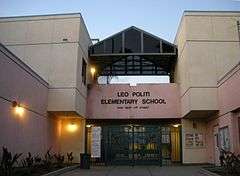
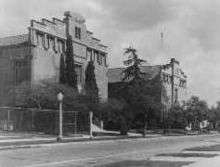
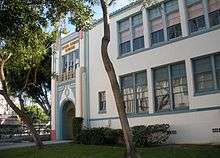
LAUSD serves all of the following communities:
- Bell
- Cudahy
- Florence
- Gardena
- Huntington Park
- Lomita
- Los Angeles – Including, but not limited to:
- List of districts and neighborhoods of Los Angeles
- excluding a small portion of West Hills which is in the Las Virgenes Unified School District
- Some areas of Los Angeles with Beverly Hills addresses, i.e. Beverly Hills Post Office, are located in LAUSD
- Marina del Rey
- Maywood
- San Fernando
- Topanga
- Universal City
- Vernon
- View Park
- Walnut Park
- West Athens
- Westmont
- West Hollywood
and portions of the following communities:
- Carson
- Commerce
- East Los Angeles (other parts of East Los Angeles are served by Montebello Unified School District)
- Hawthorne
- Inglewood
- Long Beach
- Monterey Park
- Rancho Palos Verdes (most other parts of Rancho Palos Verdes are served by the Palos Verdes Peninsula Unified School District)
- South Gate (eastern portion of South Gate is served by the Paramount Unified School District)
- West Compton
- Willowbrook
List of schools and properties
LAUSD has 219 year-round schools and 439 schools on the traditional calendar. In 2005, 47% of all LAUSD students were enrolled in year-round schools,[80] but that has declined with construction of new schools and reduced enrollment as a result of the economic recession, such that in the 2012–13 school year, only three schools were on a year-round schedule.[81]
Edward R. Roybal Learning Center
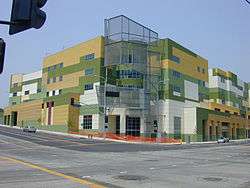
The Edward R. Roybal Learning Center (previously known as Belmont Learning Center or Vista Hermosa Learning Center), in the densely populated Westlake district just west of downtown, was originally envisioned as a mixed-use education and retail complex to include several schools, shops and a public park. After more than a decade of delays stemming from the environmental review process, ground was broken for construction in 1995. Midway through construction, it was discovered that explosive methane and toxic hydrogen sulfide were seeping from an old underground oil field. Later, an active surface fault was found under one of the completed buildings, necessitating its removal. The LAUSD had spent an estimated $175 million on the project by 2004, with an additional $110 million budgeted for cleanup efforts. The total cost is estimated by LAUSD at $300 million. Critics have speculated that it may end up costing closer to $500 million. Designed by architectural firm DLR Group WWCOT, the school opened in 2008 as the "Edward R. Roybal Learning Center".
Ambassador Hotel (Robert F. Kennedy Community Schools)
Another controversial project has been the development of the Ambassador Hotel property on Wilshire Boulevard in densely populated Koreatown. The LAUSD fought over the landmark with, among others, Donald Trump (with the legal battle dating back to 1989). In 2001, the LAUSD finally obtained legal ownership of the property. Plans to demolish the building, the site where Senator Robert F. Kennedy was shot, were met with strong opposition from preservationists. In August 2005, LAUSD settled a lawsuit over the matter that had been filed by numerous preservationist groups: most of the Ambassador complex would be destroyed, but the Paul Williams-designed coffee shop and the Coconut Grove nightclub would be preserved, with the Grove serving as the auditorium for a new school to be built on the site. Demolition began in late 2005 and the last section of the hotel fell on January 16, 2006.
The project construction became the most expensive school in the United States. It has three Elementary schools, three Middle schools, and four high schools including LAHSA. The Robert F. Kennedy Community Schools opened in September 2010 at the cost of $578 million to serve 4,200 K-12 students. Costs in 2010 were $350 per 1 square foot (0.093 m2). Amidst great controversy the district attributed the high costs to material, land prices, seismic code, and unionized labor.[82]
Santee Dairy
In 2005, soil samples taken at the LAUSD-owned site of a former Santee Dairy facility in South Los Angeles found high levels of carcinogens in soil used as foundation fill for a high school then under construction. A small controversy brewed on the matter, with some neighborhood activists and LAUSD critics claiming a repeat of the Belmont Learning Center fiasco. State scientists determined that the contaminated soil was sufficiently deep to pose no threat to students on the site, and the now-called Santee Educational Complex opened its doors in July 2005.
Park Avenue Elementary School
On February 9, 2000, the Los Angeles Weekly published an article about the environmental troubles of Park Avenue Elementary School.[83]
Metro Charter Elementary School
Metro Charter Elementary School (also known as MCES) was a public charter elementary school that was embroiled in controversy due to its constant movement and lack of a permanent campus in Downtown Los Angeles. It was started by a group of parents who wanted to created a school that was in the Downtown area and had the effort led by Simon Ha and Mike McGalliard.[84][85][86][87] On September 3, 2013, the school was established in the California Hospital Medical Center in South Park.[85][88][89]
The site was only meant to be temporary, and the school suffered from overcrowding at the Medical Center due to the growing student population, so the school searched for a new site. In 2016, Metro Charter expressed interest to co-locate the school with Castelar Elementary in Chinatown for the 2016-17 school year, but faced opposition from the parents, community stakeholders, and teachers of the school. [90][91] Many parents of Metro Charter also opposed the plan, as the plan only assigned five classrooms with Castelar out of the twelve classrooms requested, and proposed to split Metro Charter into three separate campuses for the seven other classrooms.[92] Because of the opposition to the plan on both sides, Metro Charter announced that they would not co-locate to Castelar, stating that the move would be "neither logistically nor financially viable."[91][92]
For the 2017-18 year, Metro Charter chose to split the campus so that half would go to 700 Wilshire and the other half would go to the Ketchum-Downtown YMCA building, both in the Financial District.[93][94][95] The school secured a deal with 700 Wilshire, but failed to acquire a deal with the Ketchum-Downtown YMCA building, as the YMCA lacked permits for the school. The school then signed a lease with Pleasant Hills Baptist Church in Leimert Park to house the lower grades.
In 2018, Metro Charter announced that the school would be relocating to 2635 Pasadena Avenue in Lincoln Heights after signing a lease for two years. The Metro Charter board approved signing the two-year lease with the Los Angeles Boys & Girls Club for the new location on May 22, while also voting to terminate the leases at 700 Wilshire and at Pleasant Hill Baptist Church. [96] On July 8, 2019, Metro Charter officially closed, with the faculty citing declining enrollment as the reason for its closure.[86] Many of its founders and helpers expressed sadness about the schools closure, including Councilman José Huizar, who advocated for the charter's approval. He has called for LAUSD to "help find sites and address education options within Downtown to meet the growth of the Central City."[86] Simon Ha, one of the original founders, has stated that "the irony is that the growth and popularity of Downtown — everyone wants to be here! — made it impossible for Metro Charter to remain in Downtown — we can’t afford to be here."[97]
Ellen Ochoa Learning Center
Superintendents
The following is a list of LAUSD Superintendents (additional information is needed to complete the list between 1870 and 1971)
- 1870 – 1872: No Superintendent
- 1872: A. G. Brown (resigned)
- 1872 – 1876: Dr. W. T. Lickey
- 1876 – 1880: C. H. Kimball
- 1880 – 1881: Mrs. C. B. Jones
- 1881 – 1883: J. M. Quinn
- 1883 – 1885: L. D. Smith
- 1885 – 1893: W. M. Freisner
- 1893 – 1894: LeRoy D. Brown
- 1894 – 1895: Preston W. Search
- 1895 – 1906: James A. Foshay
- 1906 – 1910: Dr. Ernest C. Moore
- 1910 – 1916: John H. Francis
- 1916 – 1920: Dr. Albert Shiels
- 1920 – 1929: Susan Miller Dorsey
- 1929 – 1937: Frank Bouelle
- 1937 – 1948: Dr. Vierling Kersey
- 1948 – 1954: Alexander J. Stoddard
- 1954: Harry M. Howell (interim)
- 1954 – 1956: Claude Lamar Reeves
- 1956 – 1962: Ellis A. Jarvis
- 1962 – 1970: Jack P. Crowther
- 1971 – 1981: William J. Johnston
- 1981 – 1987: Harry Handler
- 1987 – 1990: Leonard M. Britton
- 1990 – 1992: William R. Antón
- 1992 – 1997: Sidney A. Thompson (interim)
- 1997 – 2000: Ruben Zacarias
- 2000: Ramon C. Cortines (interim)
- 2000 – 2006: Roy Romer
- 2006 – 2009: David Brewer
- 2009 – 2011: Ramon C. Cortines
- 2011 – 2014: John Deasy
- 2014 – 2016: Ramon C. Cortines (interim)
- 2016 – 2018: Michelle King
- 2018: Vivian Ekchian (interim)
- 2018 – present: Austin Beutner
United States Academic Decathlon
The following LAUSD schools have won the United States Academic Decathlon:
- John Marshall High School, 1987, 1995
- William H. Taft High School, 1989, 1994, 2006
- El Camino Real High School, 1998, 2001, 2004, 2005, 2007, 2010, 2014
- Granada Hills Charter High School, 2011, 2012, 2013, 2015, 2016, 2017, 2019
Magnet programs
As of January 2014, LAUSD has 191 magnet schools with about 53,500 students. In 2012, the school district admitted 16,000 new students into these magnet schools out of a pool of 66,000 applications. Cara Mia DiMassa of the Los Angeles Times said that the schools, "designed to be among the best campuses in the district, mostly are as competitive for applicants as any popular private school."[98]
LAUSD's magnet schools include gifted and highly gifted schools, as well as a large number of magnet programs focusing on students with specific interests, including multiple arts-related magnet programs, multiple science-related magnet programs, multiple pre-law magnet programs, and multiple pre-medical magnet programs. There are also dozens of specialty magnet programs for students with other specific interests.[99]
The district assigns points to prospective applicants based on certain conditions: students who have applied for magnet schools before receive additional points, students who live in overcrowded zoned schools receive points, and students who live in mostly minority communities receive points. In addition, the magnet schools have racial quotas. Each school is to have 30–40% non-Hispanic White students and 60–70% minority students. As of 2011, within LAUSD, 90% of the overall student body consists of racial and ethnic minorities.[98]
The magnet schools were established in 1977 as an alternative to forced desegregation busing. The racial quota system was devised at a time when the integration focus was on making Black and White students attend school together. Since then, the district demographics changed.[98]
As of January 2005, of the Hispanic students in LAUSD, 1.2% attended magnet schools. Of the White students in LAUSD, 16% attended magnet schools. Of all magnet school students, 46.5% are Hispanic, 20% are White, 19.2% are Black, 10.2% are Asian, 3.6% are Filipino, and .6% are other. The overall LAUSD student body was 72.8% Hispanic, 11.6% Black, 9% White, 3.8% Asian, 2.2% Filipino, and .6% other.[100]
Notable staff members
Notable teachers
- Fay Allen was the first African-American woman to be elected to the Los Angeles Unified School District board.[101]
- Migdia Chinea, Cuban-American screenwriter, has taught English, Physical Education, Spanish, Art, Social Sciences and other subjects at various LAUSD schools in the Central District.[33]
- Jaime Escalante taught students calculus at Garfield High School in the East Los Angeles CDP of Los Angeles County for many years, as dramatized in the movie Stand and Deliver.
- Ezola B. Foster, right-wing African-American political activist, taught in various LAUSD schools from the 1960s until the early 1990s.
- Scott Perry, former American football defensive back in the National Football League, played professionally for the Cincinnati Bengals. Teaches first grade at Point Fermin Elementary School[102]
- Essie Mae Washington-Williams, daughter of Strom Thurmond, taught typing in the district from 1967 until 1997.
Notable alumni
- Jordan Farmar (born 1986) - basketball player
- Richard Steven Valenzuela (Ritchie Valens) - Mexican American singer, songwriter, and guitarist
All District High School Honor Band
The All District High School Honor Band members are invited in September each year to audition for the band, which includes only brass and percussion instruments. The group has marched in every Tournament of Roses Parade since 1973. The All District High School Band allows members the opportunity to perform in Bandfest, at Disneyland, and on other events. The 300 members are required "to maintain a 2.5 or greater grade point average, and stay in good standing with home school program."[103]
Originally organized to meet the minimum requirement of having 100 members on the band to perform in the Rose Parade, the Honor Band has performed at Anaheim Stadium, Hollywood Bowl, Hollywood Christmas Lane Parade (now Hollywood Christmas Parade), Los Angeles Memorial Coliseum, Rams and Raiders football games, and Super Bowls XI, XIV, and XVII. They were present at the Governor's Inauguration in Sacramento, XXIV Olympiad Salute, and the World Series during the past 25 years. In May 1986 the band traveled to Atlanta to participate in Coca-Cola's Centennial Celebration, and at the end of the month, participated in Hands Across America where the band was the "anchor" at the event's Western terminus at the RMS Queen Mary pier in Long Beach, California.
Questioning of school librarians
In May 2011, attorneys for LAUSD began scrutinizing the practice of their own teacher-librarians in an attempt to balance the district's budget. Librarians who could demonstrate they had taught within the past five years could avoid layoff by being classified as teachers.[104][105][106]
Demographics
As of the 2011-2012 school year, in its enrollment breakdown by ethnic group, 72.3% of its students were of Hispanic origin, of any race; 10.1% of the student population was of Non-Hispanic white ancestry; 9.6% of its students were African American, while Asian American students comprised 4%; students of Filipino origin formed 2.1% of the student population and Native Americans and Pacific Islanders together comprised less than 1%.[107] Black students were six times more likely to be arrested or given a ticket than white students, which contributed to the decision in 2014 to decriminalise school discipline so that minor offences would be referred to school staff rather than prosecuted.[108]
As of 2008 the district had 6,468 students from families which spoke the Armenian language; 3,338 of them went to schools in Local District 2 in the San Fernando Valley.[109]
See also
References
- "FSD Home". Laschools.org. Retrieved February 17, 2020.
- "Los Angeles Unified School District "Fingertip Facts" 2016-2017" (PDF). Retrieved March 2, 2017.
- Largest Employers in Los Angeles County. Compiled by the LA Almanac, Source: California Employment Development Department, The Los Angeles Business Journal, and Almanac research
- "The Los Angeles School Police Department". Archived from the original on August 11, 2006. Retrieved October 20, 2006.
- Jon Fullerton, Budget and Financial Policy Unit For the Board of Education – Overview of School Finance and the LAUSD Budget Presentation to the Presidents’ Joint Commission. (Archive) August 11, 2005 – See slides 24 "LAUSD Has Almost as Many Buses as the MTA and Many More Routes", 25 "LAUSD Provides Almost Twice as Many Meals as Local McDonald’s" and 26 "LAUSD Is Executing One of the Largest Public Works Projects in the Nation"
- "Where Have All the Seniors Gone?" (PDF). Archived from the original (PDF) on July 28, 2011. Retrieved September 6, 2010.
- "BOARD OF EDUCATION OF THE CITY OF LOS ANGELES : Governing Board of the Los Angeles Unified School District : REGULAR MEETING MINUTES". Archived from the original on October 18, 2002. Retrieved February 11, 2008.
- Joel Rubin, Los Angeles Times Staff Writer – Payroll system beset from Day 1. Poor management, software failures and breakdowns in training led to a yearlong crisis at L.A. Unified. Los Angeles Times, February 11, 2008,
- "LAUSD dropout rate lower after second look". Dailynews.com. Archived from the original on June 8, 2013. Retrieved December 15, 2015.
- LAUSD. "201 1 – 12 GRADUATION AND DROPOUT RATES" (PDF). LAUSD. Archived from the original (PDF) on April 8, 2013.
- Helfand, Duke, "Shake-ups Launched at Four Schools," Los Angeles Times January 11, 2002: A1.
- Sara B. Mata (September 5, 2006). "News Release". Retrieved December 15, 2015.
- "Events | Board of Education - Los Angeles Unified School District". Laschoolboard.org. Retrieved December 15, 2015.
- "L.A. school board's Ref Rodriguez pleads guilty to conspiracy and resigns". latimes.com. July 23, 2018.
- "DataQuest (CA Dept of Education)". Data1.cde.ca.gov. Retrieved March 2, 2019.
- "Archived copy". Archived from the original on February 7, 1998. Retrieved September 23, 2008.CS1 maint: archived copy as title (link)
- Haro, Carlos M. Mexicano/Chicano Concerns and School Desegregation in Los Angeles. Los Angeles, Chicano Studies Center Publications, 1977.
- Furman, Andrew. My Los Angeles in Black and & (almost) White. Syracuse, Syracuse University Press, 2010.
- Los Angeles Unified School District Board of Education records, 1875-2012 housed at the UCLA Library Special Collections
- Crawford v. Board of Ed. of Los Angeles 458 U.S. 527 (1982)
- Crawford v. Board of Educ. of the City of Los Angeles, 200 Cal. App. 3d 1397, 1402 (1988).
- Bustop, Inc. v. Los Angeles Bd. of Ed., 439 U.S. 1380 (1978)
- Bustop, Inc. v. Los Angeles Bd. of Ed.439 U.S. 1384 (1978)
- David S. Ettinger – The Quest to Desegregate Los Angeles Schools Archived February 28, 2008, at the Wayback Machine. Los Angeles Lawyer, a publication of the Los Angeles County Bar Association. March 2003
- Los Angeles School Monitoring Committee Records housed in the UCLA Library Special Collections
- Paul Egly Papers, 1977-1981 housed in the UCLA Library Special Collections
- Helene V. Smookler Collection of Material About the Desegregation of the Los Angeles Unified School District, ca. 1969-1981 (Box 13) housed in the UCLA Library Special Collections
- Ibid
- United States Comm. On Civil Rights. A report A Generation Deprived: Los Angeles School Desegregation, May 1977, U.S. Government Printing Office, 1977.
- United States Comm. On Civil Rights. A report on School Desegregation in the Los Angeles Unified School District by David Lopez-Lee, December 1976, U.S. Government Printing office, 1976.
- King, Nicelman J. The Los Angeles Experience in Monitoring Desegregation: Progress and Prospects. Santa Monica, The Rand Corporation, 1980.
- LAUSD List of Union Contracts, LAUSD.net, accessed on January 6, 2019
- Associated Administrators of Los Angeles website, accessed on January 6, 2019
- "In 1970 Strike, Students Partied by Teachers Lost Battle and Pay", LA Times, Sam Enriques, May 13, 1989
- "Teacher Strike Spreads Chaos In Los Angeles", New York Times, May 16, 1989
- History of UTLA, UTLA.net, accessed on January 6, 2019
- Analysis of The 1989 Teacher Strike, Stephanie Clayton, Learning in L.A. Project, 2008
- "With a Los Angeles teach strike approaching, some echoes resonate from 1989", Mike Antonucci, LAschoolreport.com, January 2, 2019
- History of UTLA, UTLA.net, accessed on January 6, 2019
- LAUSD teachers back one-day strike, LA Daily News, May 1, 2009
- "Possible LAUSD Strike Would Be First Since 1989, Los Feliz Ledger, Sarah Favot, September 27, 2018". Archived from the original on January 7, 2019. Retrieved January 6, 2019.
- "We've Officially Moved Into The 'Fact-Finding' Phase Of A Possible LAUSD Teacher Strike, Kyle Stokes, laist.com, October 12, 2018". Archived from the original on January 7, 2019. Retrieved January 6, 2019.
- UTLA and LAUSD conclude fact-finding presentations, UTLA.net, December 5, 2018
- L.A. teachers strike appears more likely as a key report fails to bring the union and district together, Howard Blume, December 18, 2018
- "LA Teachers Go On Strike For First Time In 30 Years". KCAL 9 Los Angeles. January 14, 2019. Retrieved January 22, 2019.
- Charles T. Kerchner, Professor of Education Claremont University – Presentation to LAUSD follow up letter Archived August 10, 2007, at the Wayback Machine. August 23, 2005. Summary: Follow up letter to LAUSD board following a presentation.
- "The NEW LAUSD - Eleven Local Districts". Lausd.k12.ca.us. Retrieved December 15, 2015.
- https://web.archive.org/web/20110708220533/http://www.dailybreeze.com/ci_10341267. Archived from the original on July 8, 2011. Retrieved June 15, 2009. Missing or empty
|title=(help) - "Audit: Weak oversight at LAUSD facilities department". Archived from the original on June 28, 2011. Retrieved November 13, 2010.
- "School district finds irregularities in $65M worth of contracts". Archived from the original on June 21, 2011. Retrieved November 13, 2010.
- "Los Angeles Unified School District" (PDF). Laschools.org. Retrieved December 15, 2015.
- "Teamsters Rally at LAUSD Tue Nov 9th at Noon – CNN iReport". CNN.
- "L.A. crime is rising where it hurts". Archived from the original on January 8, 2008. Retrieved January 10, 2008.
- "Miramonte aide's love letters to pupil investigated". Latimes. February 8, 2012. Retrieved December 15, 2015.
- Dillon, Nancy (February 7, 2012). "Colleague delivered students to accused child-molesting teacher: Lawyer". New York Daily News.
- "Schools chief announces entire Miramonte staff to be replaced | L.A. NOW | Los Angeles Times". Latimesblogs.latimes.com. February 6, 2012. Retrieved December 15, 2015.
- "Los Angeles-area school teacher accused of sexually abusing up to 20 kids". Fox News. January 24, 2013. Retrieved December 15, 2015.
- "Estey Bomberger Announces Jury Awards Molestation Victim $23 Million : LA Unified School District to Pay $6.9 million". Archived from the original on January 2, 2013. Retrieved March 11, 2013.
- Howard Blume (December 19, 2012). "Jury awards $6.9 million to boy molested by L.A. Unified teacher - latimes". Articles.latimes.com. Retrieved December 15, 2015.
- "Jury Rules LA Schools Must Pay $6.9M To Boy Molested By Teacher « CBS Los Angeles". Losangeles.cbslocal.com. December 18, 2012. Retrieved December 15, 2015.
-
Specifically, AB 1381:
- Removes power from the Board of Education and gives it to the superintendent. The superintendent is permitted to request state waivers, hire and fire principals, negotiate and execute contracts, locate and close schools, and manage all personnel. The school board still retains the sole authority to use eminent domain, place taxes and bonds on the ballot, and negotiate with the unions.
- Creates a council of mayors consisting of mayors of all cities in the LAUSD and members of the Los Angeles County Board of Supervisors who have territory in the LAUSD. This council selects the LAUSD superintendent, takes a look at the budget and makes changes before the school board (with the school board retaining only approval authority, without the ability to make changes). The council of mayors is weighted by population, but must act by a 90% of the population, effectively giving control to the mayor of Los Angeles while requiring him to seek consensus from a few other cities. The city of Los Angeles has 82% of the residents in LAUSD.
- Allows the mayor of Los Angeles and superintendent, through a joint partnership, direct control over three "clusters" of low-performing schools (defined as a high school and all of its feeders, with the high school one of those in the bottom 20% statewide).
- The "Southeast Schools Coalition" composed of the cities of Bell, Cudahy, Huntington Park, Maywood, South Gate, and Vernon is given the right to ratify its local minidistrict superintendent.
- AB 1381 – Gloria Romero Educational Reform Act of 2006. California State Legislature As Amended August 28, 2005
- Naush Boghossian and Rick Orlov – Judge sets hearing on LAUSD case Archived July 13, 2007, at the Wayback Machine Los Angeles Daily News (link no longer available) – copy available at theFreelibrary
- Blume, Howard. "L.A. Unified to get $6.4 million in settlement over iPad software". Los Angeles Times. Retrieved September 12, 2017.
- Pickert, Kate. "How the iPad Helped Bring Down the Los Angeles Schools Chief". time.com. Retrieved September 12, 2017.
- "All Los Angeles Unified schools closed by 'credible threat' of violence". Msn.com. September 11, 2001. Retrieved December 15, 2015.
- "LA Police say schools threat was 'not credible'". San Gabriel Valley Tribune. December 12, 2015. Retrieved December 12, 2015.
- "Threat that closed down L.A. schools appears to be a hoax, congressman says". LA Times. Retrieved December 16, 2015.
- "LAUSD threat live updates: Second-guessing is easy, L.A. police chief says". LA Times. Retrieved December 16, 2015.
- "Michelle King will head L.A. schools as the search for a superintendent continues". LA Times. Retrieved March 2, 2016.
- "Handling of L.A. schools shutdown offers a civics lesson". LA Times. Retrieved December 19, 2015.
- "Teaching the teachers about Islam? Some say a workshop turned political". Orange County Register. November 18, 2017. Retrieved January 13, 2019.
- Merken, Stefan (April 2016). "FOR & the BDS Movement" (PDF). Jewish Peace Fellowship. Retrieved January 13, 2019.
- Eitan Arom (November 3, 2017). "Dispute Over Bias in LAUSD Course on Islam". Jewish Journal. Retrieved January 14, 2019.
- "Wiesenthal Center Demands LA Unified School District To End "Anti-Israel Mideast Workshop For Teachers" | Simon Wiesenthal Center". www.wiesenthal.com. Archived from the original on January 14, 2019. Retrieved January 14, 2019.
- "Teaching the teachers about Islam? Some say a workshop turned political". Orange County Register. November 18, 2017. Retrieved January 13, 2019.
- "Why Is the LA Unified School District Pushing a Palestinian Narrative?". Algemeiner.com. Retrieved January 13, 2019.
- Southern California Consortium on Research in Education Archived June 15, 2005, at the Wayback Machine. districts and schools – schools – Understanding Year-Round Schools, August 27, 2005. Data Sources CDE.ca.gov Archived June 4, 2004, at the Wayback Machine, (Datafiles), CDE.ca.gov, (Dataquest) and CDE.ca.gov Archived March 16, 2004, at the Wayback Machine (Demographics) (California Department of Education)
- "2012-2013 PARENT CALENDAR KEY DATES AND HOLIDAYS FOR SINGLE AND MULTI-TRACK SCHOOLS" (PDF). Home.lausd.net. Archived from the original (PDF) on August 24, 2014. Retrieved December 15, 2015.
- Hoag, Christina (August 23, 2010). "Los Angeles school has $578M price tag". Burlington, Vermont: Burlington Free Press. pp. 5A.
- Howard Blume. "OOZING ASPHALT JUNGLE : Vapor bubbles appear on playground of Cudahy school". Archived from the original on September 30, 2007. Retrieved July 18, 2007.
- Guzmán, Richard (November 30, 2011). "Downtown Families Hope to Start Charter School by 2013". Los Angeles Downtown News.
- Banks, Sandy (June 9, 2015). "Metro Charter school's vision coming into focus". L.A. Times.
- Thomas, Sean (July 12, 2019). "Metro Charter Elementary Closes". Los Angeles Downtown News.
- Guzmán, Richard (July 30, 2013). "No Summer Vacation as Downtown Charter School Preps for Sept. 3 Opening". Los Angeles Downtown News.
- "METRO CHARTER SCHOOL" (PDF). LAUSD.
- "Charter School Petition is Approved". Los Angeles Downtown News. February 13, 2013.
- Wong, Martin (March 8, 2016). "Castelar Elementary Needs Your Help". The L.A. Beat.
- Clough, Craig (May 4, 2016). "UTLA-led rally at Castelar Elementary puts charters in crosshairs". L.A. School Report.
- Stokes, Kyle (April 28, 2016). "Charter schools sharing LAUSD campuses: Nobody loves it, everyone has to live with it". 89.3 KPCC.
- Kim, Eddie (April 7, 2017). "Metro Charter Likely to Split Into Two Campuses This Fall". Los Angeles Downtown News.
- Kim, Eddie (March 13, 2017). "Metro Charter School Still Can't Find a Home". Los Angeles Downtown News.
- Kim, Eddie (September 2, 2014). "Downtown Charter School Starts Year 2 With More Kids, New Principal". Los Angeles Downtown News.
- Thomas, Sean (May 25, 2018). "Metro Charter Elementary to Move to Lincoln Heights". Los Angeles Downtown News.
- Ha, Simon (September 10, 2018). "Looking Back at Metro Charter". Los Angeles Downtown News.
- DiMassa, Cara Mia. "At Magnet Schools, Getting In Is 1st Test." Los Angeles Times. 1. Retrieved on January 15, 2012.
- "LAUSD website including a list of magnet programs".
- DiMassa, Cara Mia. "At Magnet Schools, Getting In Is 1st Test." Los Angeles Times. 2. Retrieved on January 15, 2012.
- "An earlier pioneer on the L.A. school board". LA Times Blogs - Readers' Representative Journal. April 7, 2010. Retrieved January 16, 2018.
- "Scott Perry '76 Profile: Williams – NFL – teaching 1st grade". Williams Athletics. Retrieved December 3, 2012.
- "Los Angeles All District Honor Band". Laallcityband.com. Retrieved December 15, 2015.
- Hector Tobar (May 13, 2011). "LAUSD librarians: The disgraceful interrogation of L.A. school librarians". Latimes. Retrieved December 15, 2015.
- "California Budget Battle Continues — Which Way, L.A.? — KCRW". Kcrw.com. May 16, 2011. Retrieved December 15, 2015.
- "LAUSD librarians, fighting for their jobs, get a grilling". Archived from the original on May 19, 2011. Retrieved May 19, 2011.
- "District Enrollment by Ethnicity - Enrollment by Ethnicity for 2011-12". Dq.cde.ca.gov. Retrieved December 15, 2015.
- "Old school rap: LA pupils face teacher for minor crimes". London Evening Standard. August 22, 2014. p. 26.
- Sanchez, George B. "LAUSD's rehire of Armenian staffer rankles some" (Archive). Los Angeles Daily News. November 9, 2008. Retrieved on January 5, 2016.
Further reading
- Donovan, John T. “A Tale of Two Strikes: The Formation of United Teachers-Los Angeles and the Los Angeles Teachers Strikes of 1970 and 1989,” Southern California Quarterly Vol. 81. No. 3 (Fall 1999), 377-496.
- Donovan, John T., “Helen Bernstein and United Teachers-Los Angeles, 1990-1996,” Southern California Quarterly Vol. 83. No. 4 (Winter 2001), 399-414.
- Raftery, Judith. Land of Fair Promise: Politics and Reform in Los Angeles Schools, 1885-1941 (Stanford University Press, 1992).
- Ravitch, Diane. Reign of Error: The Hoax of the Privatization Movement and the Danger to America’s Public Schools (Vintage Books, 2014).
- Ryan, Howard. Educational Justice: Teaching and Organizing against the Corporate Juggernaut (Monthly Review Press, 2016).
- (in Japanese) (with English abstract) Tanaka, Makiko. "The English Language Development Program of the Los Angeles Unified School District : Implications for Elementary School English Education in Japan." (カリフォルニア州ロサンゼルス統一学区における英語教育の試みと日本における小学校英語教育への示唆, Archive) The Journal of Kanda University of International Studies (神田外語大学紀要). Kanda University of International Studies. 2009, Volume 21.
External links
| Wikimedia Commons has media related to Los Angeles Unified School District. |
- Los Angeles Unified School District Web site
- Los Angeles School Police Department Web site
- Los Angeles Unified School District Facilities Services Division
- LAUSD District 6
- Enrollment Statistics
- United Teachers Los Angeles website
- Los Angeles Unified School District All District High School Honor Band
- A People's History of the Los Angeles Unified School District
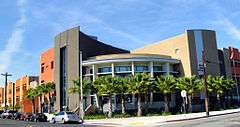
_edit1.jpg)
